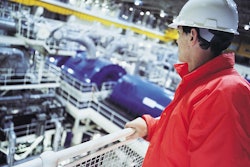Kyle Thomas of Eagle Product Inspection discusses sanitary design — its importance, and how companies need not compromise in this area where product inspection is concerned — in this Q&A.
Q: Why is sanitary design so important in the food sector?
It is vital in this sector as there is constant scrutiny where safety is concerned. Pressure from consumers, governing bodies and retailers for more and more stringent measures to be taken in the production process has led to a greater emphasis on the sanitary design of production line equipment.
If we take meat and poultry as an example, a large percentage of products are provided to the consumer in the raw state. Systems, therefore, should be designed to take into consideration elements such as harborage areas — eliminating these through design factors such as slanted contours to mitigate the risks of bacteria build up through accumulated product. Systems should also be simple to sanitize, and this is crucial to factor into the design phase. Our X-ray machines can be sanitized by a single operator in a matter of minutes, which makes a huge difference with regard to maintaining uptime.
Increasingly, manufacturers across the food sector are turning to sanitary-designed systems in order to offer higher levels of food safety. This not only makes their products more attractive to retailers, but also provides an additional layer of protection against potential product recalls.
Q: What exactly is sanitary design?
The North American Meat Institute (NAMI) originally presented a guide in 2002[1] which, in terms of sanitary design principles, has been a good workmanship style document that outlines what sanitary design should mean both to a customer and a manufacturer. Suppliers have often used this as a roadmap to be able to look at the design and to quantify whether a system is going to be compliant and fit for purpose.
Sanitary designed systems should be built to last — especially given the rigors and conditions of the environments they operate in. The robustness of a system is all-important. Robustness and precision do not necessarily go hand-in-hand, but they are not mutually exclusive, either; they must be balanced carefully, with each specifically addressed. In an X-ray system, for example, there is a generator which produces a beam that is shot through a window, through the product, through the conveyor and then through to the detector, all contained within a housing to prevent X-ray emissions. When we talk about sanitary design both inside and out, with the need to clean machines rigorously every day, we have to do so while maintaining the integrity of the technology and its safe operation. Good design practices take these varying requirements into account, with the manufacturer integrating them into a solution which effectively satisfies the needs for hygiene, longevity and precise inspection.
Q: Does an IP69 rating guarantee sanitary design?
These two things are very often confused, and the short answer is no — IP69 and sanitary design are not the same thing. IP69 is simply an ingress protection rating. Having a system with an IP69 rating does not mean you have a hygienic machine. Conversely, a sanitary design does not have to be IP69 rated, however it is a common requirement in this type of application in order to survive the rigors of sanitation over many years of cleaning cycles. The rating simply ensures that cabinets and enclosures will maintain their ingress integrity during the specified wash down process. We have machines that are IP69 rated that are not hygienically designed — whereas all our sanitary machines are designed to comply with IP69 ingress protection standards. It is important to understand this subtle, but significant, difference.
Q: Is there a right or a wrong way to approach sanitary design?
A lot of suppliers try to adapt designs that are used in general packaging for use in hostile and harsh environments, whereas at Eagle we have elected not to do that. Several systems have been intentionally designed from the ground up to follow the NAMI guidelines and to deliver machines that are built specifically for those environments and applications. To alter an existing machine and try to adapt it for a purpose for which it was not designed does not make sense.
Using specific guidelines such as NAMI, NSF and European EHEDG as the foundation for your system design is a far more sensible approach. This way, customers can be supplied with a robust product that is designed for their intended use. If you compare a product designed in this way to one that has been adapted, the differences are very noticeable. Of course, an adapted machine may be less expensive upon initial offering, but a machine designed for purpose will have a far more attractive total cost of ownership (TCO), longer life and will deliver a far bigger incremental value to the user.
About Eagle Product Inspection
Eagle Product Inspection is a pioneer in advanced x-ray inspection and fat analysis systems, delivering robust, market-leading technology and expertise to food and beverage processors and manufacturers around the world. The Eagle Product Inspection line of x-ray inspection systems evaluates in process and finished products for contaminants such as metal, glass, stone and bone while also having the ability to analyze the fat content of meat, count components, check seal integrity as well as measure mass and assess fill levels.
With its headquarters in Tampa, Florida, and local offices across the globe, Eagle Product Inspection machines meet today’s Hazard Analysis & Critical Control Points (HACCP) certification requirements. Eagle and its partners work in close collaboration to ensure that food, beverage and other consumer packaged goods manufacturers and their customers in turn can rest assured that the quality of every product is upheld.
About Kyle Thomas
Kyle Thomas, Strategic Business Unit (SBU) Manager at Eagle Product Inspection, is responsible for the expansion of Eagle's product portfolio to meet the demands of existing and potential customers in the food and beverage manufacturing and processing market. Kyle brings extensive experience and a high level of business acumen to this role, developed over 30 years with Mettler-Toledo, who acquired Eagle Product Inspection in early 2011. Kyle has held senior positions in various parts of the business, most recently as Marketing Head at Mettler-Toledo Hi-Speed in the United States. Kyle holds a BA in Marketing Management from the University of Northern Iowa.
[1] http://www.namif.org/news/ami-foundation-releases-updated-sanitary-equipment-design-principles






















